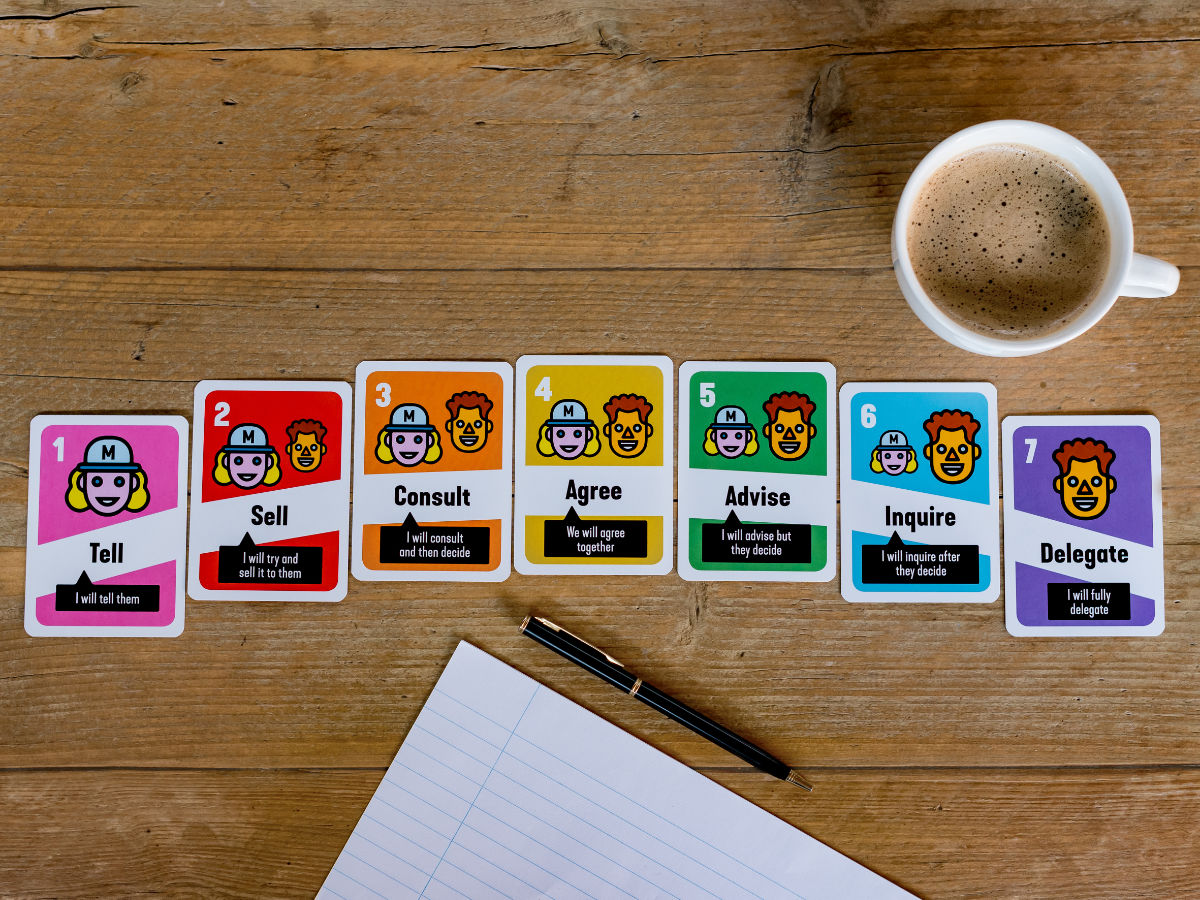Delegation Poker Karten Deutsch Download
8.00 €
- 49 cards (7 colorful cards per set, 7 sets in one package)
- Packed in a nice cardboard box
Delegation Poker (english, PDF) Lean. Deutsch, ZIP) Team- und. Die Autorin Judith Andresen verweist in dem Buch 'Retrospektiven in agilen Projekten' auf diese. You can find the game materials and download them for free here:Delegation Poker was created by Jurgen App.
- To practically do this you’ll need physical board, few sets of Delegation Poker ( or just index cards with 7 levels ), pens, markers and stickies. Explain 7 delegation levels to the team.
- Delegation is not easy. Managers often fear a loss of control when considering to allow teams to self-organize, and creative networkers sometimes don’t know how to self-organize. A delegation board enables management to clarify delegation and to foster empowerment for both management and workers.
Delivery Times and Orders FAQ

Description
Is your team ready for self-organization? Delegation Poker is a way for you and your team to implement the Seven Levels of Delegation. Together, you not only decide who does what, but to what extent does the decision-making power lie with each teammate, dependent upon the task or project. This surprisingly fun game is a great way to increase employee empowerment. Make sure someone takes notes or puts it up on a semi-permanent board in the office, so you are all on the same page!
I introduced your Delegation Poker to my project team. It helped a lot in our process of defining new responsibilities which we as a team can agree too. Now it is the base of discussion with our bosses. Even my boss understood it, he said, ‘That can be easily migrated to the RACI Matrix’. Team leader, Ortrun offshoring
Related products
Quite often, I encounter situations where no clear responsibilities are defined between two entities, such as a manager and a team or between two teams. They kind of figure itout when a situation occurs. They prefer to avoid general commitments. This can lead to confusion and misunderstandings, which in turn lead to dissatisfaction and finally to an ineffective and inefficient organisation.

A recent situation was the recruitment of a new software developer, who was accepted by the team but rejected by their superior. This led to dissatisfaction because the team felt it should decide who to hire and who not. Other situations include the tools a team is allowed to use, which trainings they are allowed to attend or who prioritises the backlog in a hierarchy of product owners (I will postpone a general discussion about a hierarchy of product owners).
On the other hand, managers often do not want to hand over responsibility. Often because they see delegation as a binary decision – either I decide, or You decide. They might fear that delegating decisions will make them powerless. This does not have to be the case. You can define intermediate stages of delegation. Based on the different leadership styles from Situational Leadership Theory (Directing, Coaching, Supporting, Delegating), Jurgen Appelo came up with different levels of delegation as shown in Figure 1.
These shades of delegation help managers to gradually transfer responsibility to a team. This way the manager can learn to trust a team, and the team learns to deal with the additional responsibility. The manager assigns more power to the team without totally renouncing his involvement. It is a major step towards self-organising teams.

It’s a bit like when parents give their children more responsibility, e.g. first they bring their child to school, later they allow their child to walk to school with friends, and later they let their child decide how to get to school by themselves. In this journey, the parents learn to trust their child and hence can focus on other tasks. The child itself gains more self-esteem, freedom and independence. It is beneficial for both sides.
Delegation Poker (by Jurgen Appelo) helps people and teams to agree on a level of delegation for key decision areas (Figure 1). Most importantly, while defining these levels of delegation, the participants have a discussion. This, in turn, fosters mutual understanding and empathy.
The levels of delegation of a specific topic range from command on the left end of the spectrum (“I tell them what to do”) to full delegation (“I leave it up to them”) (Figure 1).
Preparation
- Each participant receives a deck of cards. You can download templates for the cards or buy them at the Management 3.0 shop. For workshops or trainings, I usually print them out, laminate and cut them.
- In addition, print out some larger cards for a board that secures the final decision. Alternatively, I prepared an Excel sheet with the cards pasted into and projected it on a wall (see attachment).
- Collect topics (key decision areas) where (the levels of) responsibility is not clear in advance and invite the participants to bring these issues to the workshop.
Participants
- Ask people or representatives on both sides of one relationship, i.e. a superior and her team or two teams that work with each other. At least have two and at most eight participants to avoid too lengthy discussions. If the teams are larger, invite the teams to send representatives.
- In the latter case, the representatives should agree on the subjects before the workshops and have discussed the levels of delegation within their teams.
Execution
- Explain the background as described above (Why are we doing this? What is the expected outcome?)
- Firstly, agree on the decision areas and, if necessary, refine them to a finer-grained level. They must be clear and precise and should leave little room for interpretation; otherwise, you will have this discussion later in the process.
- Explain that the results of the workshop are an experiment, i.e. “We will test these levels of delegation for the next two months and adjust them if appropriate.”
- Each participant receives a deck of cards.
- The delegation poker then goes as follows (the process is similar to Planning Poker, which is often used for the estimation of backlog items)
- The facilitator names the topic.
- Each participant now chooses a card of the level of delegation they think is appropriate without showing the card to the other participants.
- If everyone is ready, the facilitator asks to reveal their decision.
- If the cards are distinct, the people with the highest and lowest value share their decision with the others. There will be a time-boxed discussion. Subsequently, a new voting will take place, in which the results should be more equal. The participants then should decide on one level of delegation. The discussion that leads to a mutual understanding is the most important part here.
- Repeat the steps above until all topics have been discussed.
Follow-Up
- Make the results publicly available. I usually print them out on at least A3 paper or draw them on a flip chart, which is then placed in the team space or on the floor.
- Discuss how the levels of delegation worked out in one of the retrospectives one or two months after this workshop. Write a date on the printout that indicates when the delegation matrix is being reviewed. This further emphasises the matrix as an experiment.
See Full List On Vividbreeze.com
Learnings
- The workshop mostly benefits from the discussions the participants have and the subsequent experiment (How do the decisions work in practice?)
- As a result, is seen as an experiment, people are more likely to accept it and can even live with slight disagreements. However, don’t forget to reflect on the outcome after a few weeks or months as otherwise, the participants will lose trust in this method.
- “With great power comes great responsibility” (Uncle Ben, Spiderman). In the situation I outlined above, we had a discussion about the responsibility that comes with employing a new team member. If the team wants to have the sole right to make the decision about whom to hire, it also has to deal with firing the employee if he doesn’t fit into the team (amongst other obligations). This made the team feel a bit uncomfortable and hence they agreed on delegation level 4 – Agree.

I have played Delegation Poker with teams and managers, Scrum Master and their teams, and managers at different organisational levels with great success. It supports mutual understanding and questions long-established decisions. I also experienced that managers are often okay with being advised or only informed.
Further Reading
- Delegation Poker Template (Excel)
- [amazon asin=0321712471&text=Management 3.0] by Jurgen Appelo
- [amazon asin=1119268680&text=Managing for Happiness: Games, Tools, and Practices to Motivate Any Team] by Jurgen Appelo
- [amazon asin=9081905112&text=How to Change the World: Change Management 3.0] by Jurgen Appelo
Original Images of the Delegation Poker are © Jurgen Appelo, Creative Commons 3.0 by http://www.management30.com/

- One year – Learning By Playing Meetup - 28/10/2018
- Impact Feedback - 13/03/2018
- T-Shaped Game – Consontants and Vowels - 24/01/2018